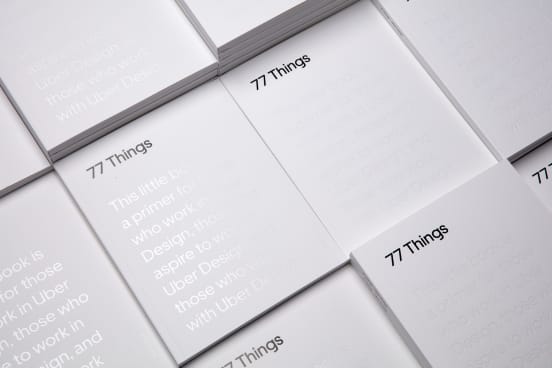77 Things about Uber Design
Over a lifetime spent crafting his design thinking, Uber’s Vice President of Product Design, Michael Gough, had an idea. Actually, he had 77 of them—77 thoughts and insights that we wanted to share with the world.
The timing couldn’t have been better. Our Brand team had recently started rethinking Uber’s brand positioning, creating a new visual identity system influenced by modernist design. Using this system to share Michael’s thoughts seemed like a perfect collaboration. The result: 77 Things, a design-forward, aesthetic exploration of some core principles of design.
Showing our range
To create this book, our team explored the boundaries of Uber’s visual identity system, working to showcase its whole range. Throughout, we followed one of the principles (No. 77) most critically: “Pattern recognition is an essential skill for creators. See the patterns in user behavior and how to change them. Understand the implicit patterns of use, layout, and function in your work. Then, make them explicit.”
Understanding our type
Principle No. 51 tells us: “Understand type and how to use it.” Our Uber Move typeface is one of our identity’s strongest assets, so we used every single weight of its display and text fonts, in different body sizes. This isn’t how we use Uber Move in our daily work, but the book was a great opportunity to show off the beautiful shape of our exclusive typeface.
We first created hierarchy by using the right pairing of fonts, such as Bold for the 77 principles and Regular for the body copy. Another way to create hierarchy is to find the right balance of sizes between a headline and body copy. Each principle in 77 Things is either the same size as its body copy or at least twice as big. We broke both these guidelines, though, inspired by a quote from Vignelli: the first spread layout uses a medium weight for both the principle and the body copy—but the principle is 13 times bigger than the body copy. This creates an obvious, pleasing contrast.
Looking to the brand
We developed many cover concepts, including kraft paper and white foil (like a workbook), but the master brand system again helped us determine the right approach: white Mohawk Superfine paper in Ultrawhite Eggshell with black and white foil deboss typography. For color inside, PMS ensured 100% accuracy with our secondary palette.
Rules of 7
- 7 colors (6 secondary, plus black, one of our main colors) were the backgrounds for each section
- 7 photos offered pattern, texture repetition, and movement
- 7 was the multiple for our grid, to maintain a pattern (No. 35: “Know the grid. Use the grid.”)
- 7pt was the grid measurement (which is tight, but the most important part of the grid is the baseline, and this let us create several body copy sizes and always set the leading to fit multiples of 7)
Considering audiences
Then we thought about the readers—their pace, how they might read it, how images could let them pause and ponder the copy. We also tested readability and pushing the brand identity to its limits, asking ourselves questions like: Is this easy to read? Are we striking the right balance between headlines and copy? Are we making the book interactive in a way that complements the content rather than distracting from it? After all, principle No. 32 says, “Interactions are relationships.” (Our interactions included changing layout orientations, creating cutouts, and offering a detachable poster.)
Using the principles
In just 4 months, we went from concept to final print. The book is available only at Uber design events or by joining our team. Others can add the Google Chrome extension on their computer.
We want the book to inspire and be shared among our audience, not to end up dusty on a coffee table or tucked away in a drawer. The title 77 Things attempts to remind designers that the book should be read from time to time: each of these principles can help hone the craft of design throughout their career.
This case study is excerpted from an article written by Braz de Pina, published on Medium on July 22, 2019.
Teams
Departments
Offerings
Locations
Asia Pacific
Europe, Middle East & Africa
Latin America
United States & Canada
Inside Uber
